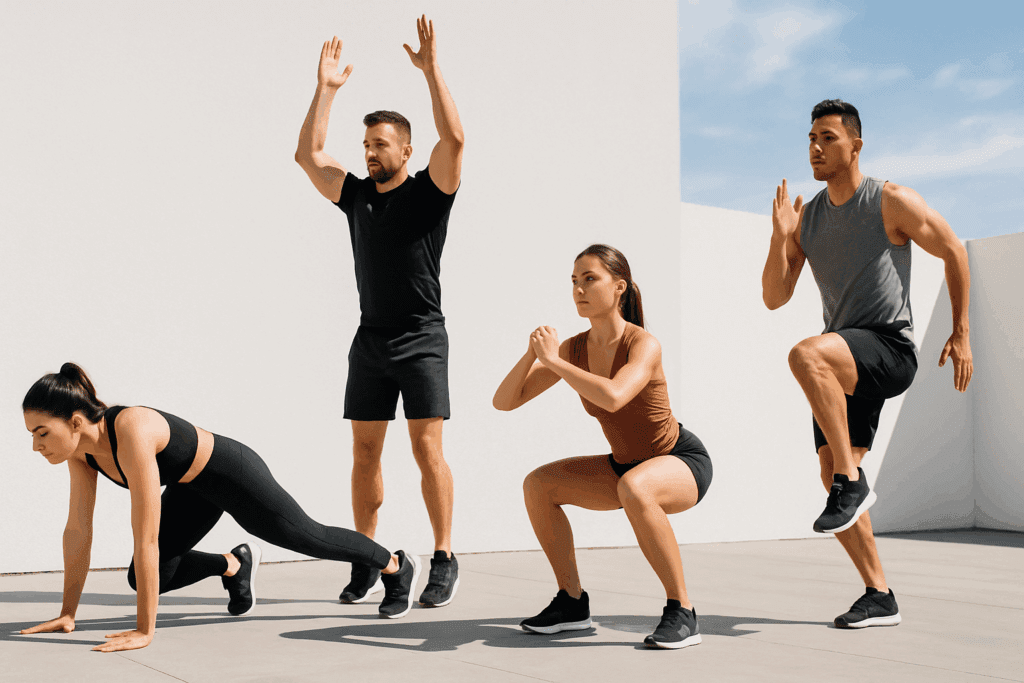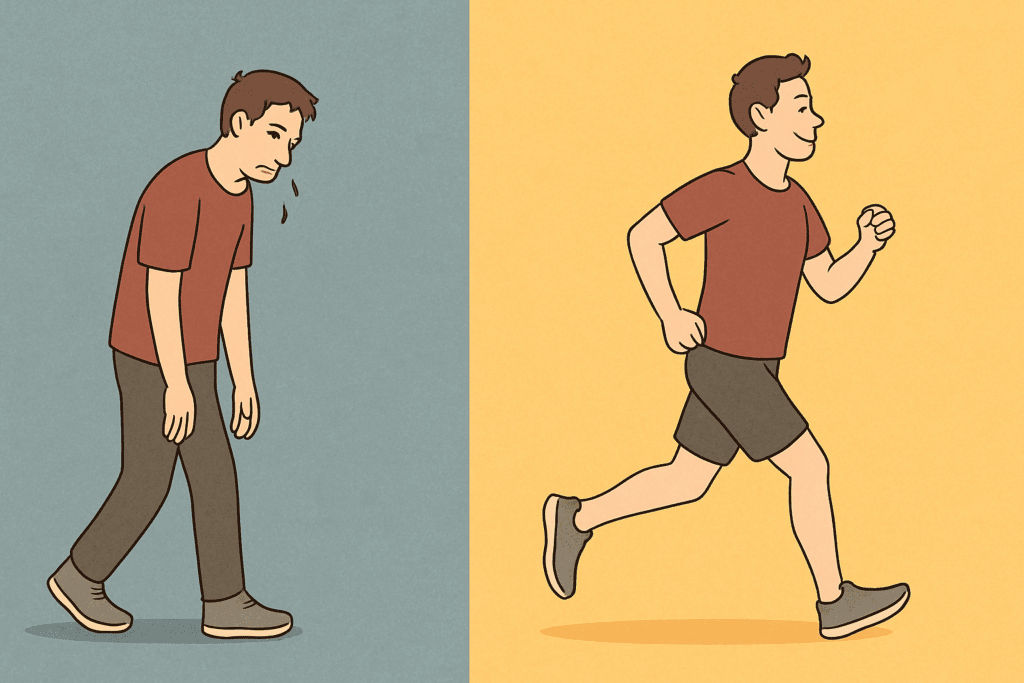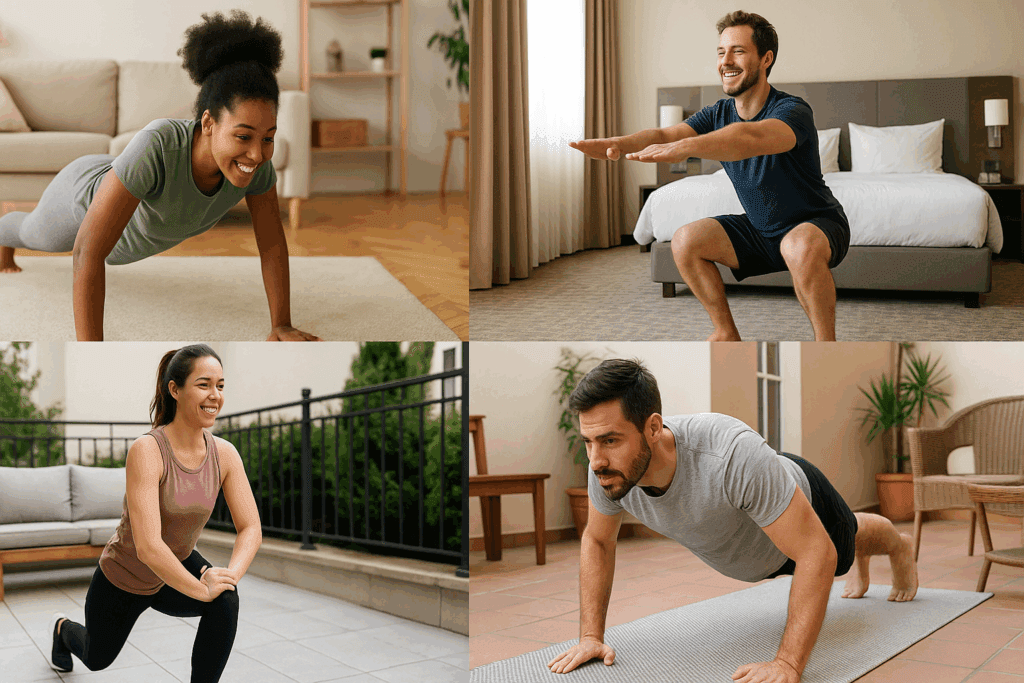Improving physical endurance doesn’t always require a long session at the gym or hours spent on a treadmill. In recent years, the fitness community has turned its attention to short, efficient routines that offer significant benefits in minimal time. Among the most popular of these is the quick ten minute workout. This fast workout format has garnered attention for its ability to deliver real gains in stamina and performance when practiced consistently. More than a fitness fad, the science behind these mini-sessions supports their capacity to enhance cardiovascular health, muscular endurance, and metabolic function. For busy professionals, students, and even competitive athletes, the ability to workout 10 minutes a day provides a practical yet powerful approach to wellness.
The growing popularity of 10 minute daily workouts is fueled not only by their convenience but by the accumulating body of research validating their impact. The notion that you must dedicate an hour to exercise for it to be effective is being replaced by a more evidence-based understanding: intensity, consistency, and form matter more than duration alone. When structured properly, even just 10 minutes of cardio a day can catalyze improvements in endurance, aerobic capacity, and energy efficiency. This article explores how ten minute workouts, even without equipment, can deliver serious results—especially when aligned with endurance and performance goals.
You may also like: How to Increase Stamina and Endurance Naturally: Smart Training Tips and Nutrition Habits That Support Cardiovascular Fitness

The Physiology Behind Endurance and Short Workouts
To understand how a ten minute a day workout can contribute meaningfully to stamina, it helps to begin with the basics of human physiology. Endurance is primarily a function of cardiovascular and muscular efficiency—how well your heart, lungs, and muscles utilize oxygen during sustained physical activity. When we perform aerobic exercise, even in short bursts, we stimulate the cardiovascular system to pump more blood, increase capillary density in muscles, and improve mitochondrial efficiency.
High-intensity interval training (HIIT) is a key principle behind the effectiveness of fast workouts. These workouts alternate short bursts of high-effort activity with brief periods of rest or lower-intensity movement. Within a 10 minute daily workout framework, HIIT becomes a powerhouse strategy that optimizes oxygen consumption and boosts VO2 max, a critical marker of endurance. While traditional endurance training typically involves long, steady-state cardio, research shows that brief high-intensity routines can provide equal or even superior improvements in VO2 max over time.
Another physiological benefit is the development of muscular endurance. In a 10 minute workout no equipment routine, bodyweight exercises such as squats, lunges, push-ups, and planks are often used in rapid succession. This approach builds muscle stamina while also improving neuromuscular coordination. Moreover, these exercises engage large muscle groups, encouraging better oxygen and nutrient distribution throughout the body. As this efficiency increases, so too does your capacity for prolonged physical effort.

Designing an Effective 10 Minute Daily Workout for Endurance
Creating a fast workout that maximizes results within a ten minute window requires intentional structure. While the brevity of the session might suggest simplicity, the most effective ten minute a day workouts are carefully curated to target multiple systems simultaneously. They typically include a mix of aerobic and resistance components, high-intensity intervals, and exercises that challenge balance, coordination, and mobility.
The ideal quick ten minute workout for endurance begins with a dynamic warm-up, even if brief, to elevate heart rate and prepare muscles for exertion. Movements such as jumping jacks, arm circles, or light jogging in place set the tone for what follows. The core of the session should consist of compound movements that activate multiple joints and muscle groups. These include mountain climbers, burpees, jump squats, and high knees—each performed for 30 to 60 seconds with minimal rest in between. This format allows for maximum cardiovascular stimulation in minimal time.
Equally important is progression. To prevent adaptation and plateauing, it is crucial to gradually increase either the intensity or complexity of the routine. This might mean increasing the pace of repetitions, shortening rest intervals, or adding variations like single-leg squats or plank jacks. Whether following a ten minute workout video or designing your own, consistency and variety are key. The goal is to continually challenge the body, prompting ongoing physiological adaptations that support enhanced stamina and performance.

How 10 Minutes of Cardio a Day Builds Endurance
Cardiovascular endurance is arguably the most direct beneficiary of short, daily cardio sessions. The concept of performing just 10 minutes of cardio a day may seem modest, but when executed with purpose and intensity, it can stimulate meaningful changes in heart health, respiratory efficiency, and aerobic capacity. The cumulative effect of these sessions over time is where the real transformation occurs.
At the heart of this transformation is cardiac output—the volume of blood your heart pumps per minute. When you engage in a ten minute a day workout that elevates your heart rate and sustains that elevation, your cardiac muscles grow stronger, your heart rate variability improves, and your resting heart rate often decreases. These are all markers of increased cardiovascular efficiency. Studies have shown that even 10-minute HIIT routines can significantly improve VO2 max and anaerobic threshold when performed regularly.
Respiratory benefits are also noteworthy. Ten minute daily workouts improve the capacity of the lungs to deliver oxygen and expel carbon dioxide. As your breathing becomes more efficient, physical activities feel less taxing. The enhanced oxygen delivery and carbon dioxide removal translate into improved performance not only in workouts but in daily life activities as well. Whether you’re climbing stairs, cycling to work, or running errands, the stamina gained from a consistent fast workout routine becomes evident.

10 Minute Workouts Without Equipment: Accessibility Meets Efficiency
One of the most empowering aspects of the 10 minute workout no equipment approach is its accessibility. You don’t need a gym membership, expensive equipment, or even much space to get started. These routines break down the common barriers to exercise, making fitness more inclusive and adaptable to a wide range of lifestyles. For individuals who travel frequently or work long hours, this format provides a consistent way to stay on track with endurance goals.
The effectiveness of bodyweight-based fast workouts lies in their ability to engage the entire body through functional movements. Exercises like push-ups, squats, and planks not only build muscle endurance but also promote joint stability and core strength. When these exercises are performed in a sequence that challenges aerobic capacity, they create a dual stimulus that boosts both muscular and cardiovascular endurance. This synergy is what makes the 10 minute daily workout so potent.
Additionally, the no-equipment format encourages mindfulness and body awareness. With no machines to guide your form, you must rely on proprioception and control, which enhances neuromuscular coordination. Over time, this heightened awareness translates into more efficient movement patterns, reduced risk of injury, and improved athletic performance. Whether you follow a ten minute workout video or simply design your own circuit, these brief yet powerful routines make fitness accessible to all.

Consistency and the Compounding Effect of Daily Movement
Perhaps the most understated yet powerful aspect of a quick ten minute workout is its ability to build momentum. Consistency is the cornerstone of any endurance training program, and short daily sessions are far easier to maintain than longer, more demanding workouts. The lower time commitment removes mental barriers to starting, making it easier to establish and maintain a habit. Over time, the compounding effects of daily movement become impossible to ignore.
This compounding effect mirrors the principle of progressive overload, albeit in a subtler form. As your body adapts to the demands of daily exercise, you can naturally scale the intensity of your sessions. What once felt challenging becomes manageable, and you can push further, harder, or longer within that same ten minute window. This upward spiral of capability reinforces motivation and encourages long-term adherence.
Beyond physical improvements, there is a psychological benefit to completing a 10 minute daily workout. The sense of accomplishment, even from a short session, boosts confidence and promotes a positive relationship with fitness. Rather than viewing exercise as a chore, many individuals begin to see it as a rewarding part of their daily routine. This mindset shift is essential for maintaining lifestyle changes that support both endurance and overall health.
Performance Enhancement Through Minimalist Training
Despite the brevity of ten minute a day workouts, their impact on athletic performance should not be underestimated. When structured strategically, these routines support improvements in speed, power, and agility—all key components of performance enhancement. For athletes in particular, the ability to supplement existing training with focused, high-effort mini-sessions can offer a valuable edge.
Speed and agility are often linked to neuromuscular efficiency and quick-twitch muscle fiber recruitment. Incorporating plyometric movements such as jump squats, bounding, or skater hops into a ten minute workout no equipment routine can sharpen these attributes. When executed explosively, these exercises stimulate the nervous system to fire more efficiently, leading to quicker reaction times and more explosive movement. This training translates directly to sports and high-intensity physical tasks.
Power development can also benefit from short, intense intervals. When time is limited, exercises like burpees or sprint intervals within a fast workout framework offer a high return on investment. These compound movements demand full-body engagement and metabolic acceleration, pushing the boundaries of muscular output. Over time, regular exposure to this kind of stimulus enhances muscular coordination, anaerobic resilience, and peak power output.
Incorporating 10 minutes of cardio a day as part of an athlete’s recovery or cross-training regimen also promotes better circulation, aids in lactic acid clearance, and maintains aerobic base without excessive fatigue. These sessions can act as a bridge between intense workouts or serve as a tune-up on lighter days. When integrated intelligently, quick ten minute workouts become a powerful complement to a well-rounded performance plan.

Tracking Progress and Maximizing Results
To truly harness the benefits of a 10 minute daily workout, tracking progress is essential. While the sessions may be brief, their cumulative impact can be profound when goals are clearly defined and results are monitored over time. This practice not only provides accountability but also informs decisions about when and how to adjust your routine.
Progress can be measured in various ways, including improvements in endurance metrics like heart rate recovery, VO2 max, and perceived exertion. Additionally, noting increases in the number of repetitions completed within a fixed time, the ability to hold certain positions longer, or simply how energized you feel after each session provides meaningful insight. Using fitness apps, journals, or even simple habit trackers can help keep the momentum going.
Consistency should always be paired with intentional variation. To avoid stagnation and continually stimulate adaptation, it’s important to modify routines every few weeks. Swapping out exercises, adjusting intensity levels, or following a new ten minute workout video can breathe new life into your training. The key is to remain engaged and responsive to your body’s evolving needs while staying anchored to your goals.
Frequently Asked Questions: Quick Ten Minute Workouts for Endurance and Performance
1. Can a fast workout really help me build endurance over time?
Absolutely. While it may seem counterintuitive, a fast workout that focuses on intensity and consistency can significantly contribute to your endurance. The key is challenging your cardiovascular system and muscle groups in a short but focused burst. Over weeks of repeating a 10 minute daily workout, your body begins to adapt by increasing oxygen efficiency, muscle coordination, and energy conservation. For many, especially those just starting or returning to fitness, this approach provides a scalable entry point that doesn’t overwhelm but still yields measurable results.
2. How can I structure a 10 minute workout with no equipment for optimal benefits?
When designing a 10 minute workout no equipment routine, focus on dynamic, compound movements that target multiple muscle groups. Try starting with high knees or jumping jacks, then move into exercises like push-ups, squats, mountain climbers, and lunges. The goal is to keep your heart rate elevated while alternating between muscle groups to avoid fatigue. Even though you’re not using weights, your own bodyweight provides ample resistance for building strength and endurance. These routines also improve coordination, mobility, and functional fitness in ways that support long-term performance.
3. Is it better to do a ten minute workout video or create my own routine?
Both options have their advantages. A ten minute workout video offers guidance, structure, and often motivation through visual and verbal cues. It’s ideal for beginners or those who want variety without planning. Creating your own routine, however, allows for personalization based on your fitness level, specific goals, and available space. If you’re training for a sport or specific event, tailoring your ten minute a day workout might better target those needs. Many people find a mix of both—alternating between videos and custom sessions—keeps them engaged and progressing.
4. How does 10 minutes of cardio a day affect heart health compared to longer sessions?
Ten minutes of cardio a day can still have significant effects on your heart health, particularly when the workout is performed at a moderate to high intensity. Even short bursts of elevated heart rate stimulate increased cardiac output, improved circulation, and better oxygen transport throughout the body. What matters most is consistency. Over time, these regular, quick ten minute workouts help reduce blood pressure, lower resting heart rate, and enhance metabolic health. This approach is especially beneficial for those with tight schedules, making cardiovascular health improvements more accessible.
5. Can I replace my regular gym session with a workout 10 minutes a day?
It depends on your goals. For general wellness, weight maintenance, or improved energy, a workout 10 minutes a day can be highly effective. However, if you’re aiming for muscle hypertrophy or competitive athletic performance, longer or more specialized training sessions may be necessary. That said, a short, consistent routine can serve as a powerful foundation or supplemental workout. On rest days, travel days, or when motivation dips, a ten minute daily workout ensures you stay active and reinforce your fitness habits.
6. What psychological benefits can I expect from a quick ten minute workout?
Aside from physical health, brief exercise sessions deliver substantial mental and emotional advantages. A quick ten minute workout can trigger the release of endorphins and dopamine, which promote feelings of positivity, reduce stress, and improve mood. Additionally, completing a fast workout provides a sense of accomplishment that boosts motivation and reinforces self-discipline. Over time, these psychological benefits contribute to improved mental resilience, better focus, and a stronger commitment to overall wellness. For individuals with demanding schedules or high-stress environments, these short routines offer a reliable coping tool.
7. What are some advanced techniques to intensify my 10 minute daily workout?
To push your endurance further, consider integrating tempo variations, isometric holds, and unilateral movements into your routine. For example, slowing down the eccentric phase of a push-up or holding a squat position for several seconds dramatically increases muscular tension and fatigue. You can also alternate sides with single-leg exercises, which engage stabilizing muscles and enhance balance. Using Tabata intervals (20 seconds on, 10 seconds rest) within your 10 minute daily workout can further boost intensity and calorie burn. These strategies allow seasoned exercisers to continue progressing despite time constraints.
8. How do I stay consistent with a ten minute a day workout schedule?
Creating consistency often requires combining habit formation strategies with environmental cues. Schedule your ten minute a day workout at the same time each day and keep it visible on your calendar or task list. Keep a mat or workout clothes in sight as visual reminders. Joining a social accountability group or using a fitness tracking app can reinforce behavior through positive feedback loops. Because these workouts are so short, it becomes easier to say yes to them daily, gradually embedding them into your lifestyle without resistance or disruption.
9. Can short workouts really improve my performance in other sports or physical activities?
Definitely. While 10 minutes may seem brief, the functional fitness gained from fast workouts translates into better athletic performance. Exercises that promote core stability, joint mobility, and high-rep muscle endurance enhance your ability to perform in longer, more demanding physical tasks. For example, improving your ability to maintain form while fatigued can prevent injuries during long runs or matches. Even elite athletes use short-duration, high-intensity sessions as cross-training or active recovery to enhance specific performance metrics. When programmed smartly, these micro-sessions build the base for broader physical success.
10. What innovations or trends are emerging in the field of ten minute fitness?
As the demand for time-efficient fitness continues to grow, technology is playing a major role in shaping the future of fast workouts. Interactive apps now offer customized ten minute workout video libraries, AI-generated routines, and real-time feedback based on movement tracking. Virtual trainers and gamified experiences make 10 minute workout no equipment options more engaging than ever. There’s also growing interest in incorporating breathwork, mobility drills, and mindfulness into short routines to provide holistic benefits. The future of quick fitness appears to be hybridized, blending endurance, recovery, and wellness into integrated micro-sessions that support total-body health.
Conclusion: The Enduring Power of a Quick Ten Minute Workout
In an era defined by time constraints and competing priorities, the appeal of the quick ten minute workout is not only understandable—it’s transformative. When designed with intention and executed consistently, these short routines hold the power to significantly boost endurance and elevate physical performance. From improving cardiovascular efficiency and muscular stamina to enhancing agility, power, and recovery, the benefits of ten minute a day workouts extend well beyond their duration.
The science supporting 10 minutes of cardio a day is compelling, and its practical applications are limitless. Whether you opt for a 10 minute workout no equipment format or follow along with a guided ten minute workout video, the possibilities are as varied as they are effective. What matters most is showing up, moving with purpose, and committing to the process. In doing so, the path to improved stamina and peak performance becomes accessible to all—one ten minute session at a time.
Was this article helpful? Don’t let it stop with you. Share it right now with someone who needs to see it—whether it’s a friend, a colleague, or your whole network. And if staying ahead on this topic matters to you, subscribe to this publication for the most up-to-date information. You’ll get the latest insights delivered straight to you—no searching, no missing out.
Further Reading:
What’s the Difference Between Endurance and Stamina?
How to Increase Stamina and Endurance for Running
How to Increase Stamina: Tips to Boost Your Endurance and Energy

